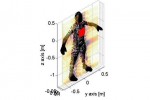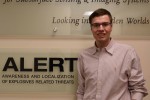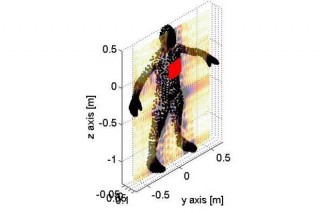News & Events
Awards and Achievements
ALERT’s Methods to Improve the Detection of Hidden Explosives Wins Patent March 3, 2017

ALERT researchers, Prof. Carey Rappaport and Prof. Jose Martinez-Lorenzo of Northeastern University were awarded a patent for “Signal Processing Methods and Systems for Explosives Detection and Identification Using Electromagnetic Radiation” (U.S. Patent 9,575,045) on February 21, 2017.
This patent is for an algorithm designed to rule out non-explosive concealed foreign objects affixed to the skin (i.e. hidden under clothing). Current security screening systems, such as AIT Millimeter Wave Scanners used at airports to scan passengers, are able to identify items with distinct shapes that are hidden on the body, such as guns and knives. However, explosives are considerably more difficult to identify in this manner, due to the fact that the size and shape of explosives can vary greatly, leading to time-consuming and potentially dangerous security pat-downs to determine if a suspicious object is a security threat, or a wallet that a passenger forgot to place in the bin.
Prof. Rappaport and Prof. Martinez-Lorenzo believe their algorithm, when plugged into existing screening systems, will greatly reduce the number of false alarms, and thus, the number of pat-downs needed, leading to greater accuracy in threat detection and shorter security lines. The improved reliability would benefit many: passengers, airlines, and the Transportation Security Administration; and possibly lead to the expansion of AIT Millimeter Wave Scanners into everyday use, such as railway stations, sporting venues, and other soft targets.
Image caption: Simulation of a human form with explosives slab affixed to chest.
Professor Rappaport Selected as an IEEE Antennas and Propagation Society Distinguished Lecturer for 2017-2019 February 21, 2017

ALERT Deputy Director and Electrical and Computer Engineering professor, Carey Rappaport of Northeastern University was selected by the IEEE Antennas and Propagation Society (AP-S) as a Distinguished Lecturer for 2017-2019. The IEEE AP-S Distinguished Lecturer Program sends experts, the Distinguished Lecturers, to visit active AP-S Chapters around the world and give talks on topics of interest and importance to the Antennas and Propagation community.
Professor Rappaport has been a Northeastern University faculty member since 1987, and has been teaching Electrical and Computer Engineering since July 2000. In 2011, he was appointed as a College of Engineering Distinguished Professor. Professor Rappaport has written over 400 technical journal articles and conference papers on various topics, including electromagnetic wave propagation and scattering computation, microwave antenna design, and bioelectromagnetics. He has also received two reflector antenna patents, two biomedical device patents, and four subsurface sensing device patents.
Professor Rappaport’s Distinguished Lecture topics include:
- “A High Gain Toroidal Reflector Antenna for Multistatic 3-D Whole Body Millimeter-Wave Imaging”
- “Multifocal Bootlace Lens Design Concepts”
- “Modeling Frequency Dependent Biological Tissue for FDTD Analysis Using a Single Pole Z-Transform Conductivity Model”
- “Localizing Tunnel Positions Under Rough Surfaces with Underground Focused Synthetic Aperture Radar”
- “Modeling Standoff Radar Scattering of Concealed Body-Worn Objects for Suicide Bomber Detection”
- “Electromagnetic Sensing and Treatment of Living Things: Using Microwaves to Detect and Treat Disease in Humans and Trees”
- “Advanced Concepts for Ground Penetrating Radar Detection of Land Mines.”
Congratulations to Professor Rappaport on being selected as an IEEE Antennas and Propagation Society Distinguished Lecturer for 2017-2019!
2016-2017 Kurlat Scholarship Awarded January 27, 2017

ALERT student, Anthony Bisulco of Northeastern University is the 2016-2017 recipient of The Saul and Gitta Kurlat Undergraduate Engineering Scholarship. This is the second year in a row that Anthony was selected for this award based on his academic excellence and strong dedication to the research he engages in with ALERT researcher, Dr. Jose Martinez. Anthony is a 3rd year undergraduate pursuing the BS in Electrical and Computer Engineering. In addition to conducting ALERT research, Anthony also serves on the ALERT Student Leadership Council.
Established in 2004, this scholarship is made possible through the generous donation of Saul Kurlat (M.S. Engineering Management, Northeastern University, Class of 1962) and his wife, Gitta Kurlat. Their endowment for a renewable scholarship award is used to support a deserving undergraduate engineering student who is actively involved in research with the Bernard M. Gordon Center for Subsurface Sensing and Imaging Systems (Gordon-CenSSIS) at Northeastern University.
ALERT Researcher Named IAPR Fellow January 27, 2017

Professor Yun Raymond Fu, ALERT researcher and interdisciplinary faculty member affiliated with the College of Engineering and the College of Computer and Information Science at Northeastern University, has been selected as a fellow of the International Association for Pattern Recognition (IAPR). Fellows are elected to the IAPR every two years as an acknowledgment of distinguished contributions in the field of pattern recognition and to the organization’s activities.
Professor Fu was selected to be a fellow for his contributions to pattern recognition, data mining and visual intelligence. Professor Fu’s research interests include machine learning and computational intelligence, social media analytics, human-computer interaction, and cyber-physical systems. He is the founding director of the Synergistic Media Learning Lab.
Additionally, Professor Fu contributes to Video Be on the Lookout (vBOLO), a project led by ALERT and VACCINE (Visual Analytics for Command, Control, and Interoperability Environments), both DHS Centers of Excellence, in conjunction with the Greater Cleveland Regional Transit Authority (GCRTA). vBOLO applies cutting-edge research in human re-identification using subjects’ clothing, gait, and faces to produce an entirely computerized system that could interface directly with a video surveillance network to automatically find re-appearances of tagged suspects. The potential impact of large-scale re-identification systems in major transit hubs and other crowded venues includes reductions in thefts, real-time or forensic tracking of suspects’ destinations or origins in surveillance video, and assessments of intervention strategies on flow rates and system efficiency.
ALERT congratulates Professor Fu on his IAPR fellowship!
ALERT Receives Funding for Strategic Initiatives November 1, 2016

The ALERT Center of Excellence at Northeastern University has received additional funding from the Department of Homeland Security for the following projects:
- A project entitled Research and Development of Systems for Tracking Passengers and Divested Items at the Checkpoint, also known by its acronym CLASP (Correlating Luggage and Specific Passengers), which will address tracking passengers and divested items at the checkpoint.
- In collaboration with the Center for Visualization at Data Analytics (CVADA), ALERT received funding to continue the development of a Video Be on the Lookout (vBOLO) system to help re-identify subjects of interest as they re-appear in a surveillance system.
- ALERT also received funding for Adaptive Automatic Target Recognition for CT-Based Object Detection Systems, otherwise known as AATR. The researchers involved with this project will develop adaptive automated target recognition (ATR) algorithms for CT-based explosive detection systems (EDS) for inspection of divested items at the checkpoint and checked luggage. The focus will be on adaptive ATR (AATR) algorithms that can be configured in the field to add new targets after deployment without having to retrain and retest the ATR.
Photo caption: Rensselaer Polytechnic Institute’s initial Airport Security Area Testbed serves as the foundation for the CLASP research effort.
ALERT Phase 2 Year 3 Annual Report Available Online! September 30, 2016

ALERT is proud to announce that the Phase 2 Year 3 Annual Report is now available for download online. This report details the continued research in ALERT’s four thrusts:
- R1 Characterization & Elimination of Illicit Explosives
- R2 Trace & Vapor Sensors
- R3 Bulk Sensors & Sensor Systems
- R4 Video Analytics & Signature Analysis
A full bibliography of publications and presentations conducted under ALERT support follows the individual project reports. Comprehensive descriptions of the Year 3 activities that took place in our Research and Transition, Education, Strategic Studies, Safety, and Information Protection Programs, as well as the ALERT Phase 2 Overview and Year 3 Highlights, Infrastructure and Evaluation, and Industrial/Practitioner and Government Partnerships can also be accessed in the Annual Report.
ALERT’s work in Improving Security Screening featured in IEEE Antennas & Propagation Magazine September 19, 2016

ALERT Bulk Sensors & Sensor Systems Thrust Leader Professor Carey Rappaport and ALERT Researcher Assistant Professor Jose Martinez Lorenzo’s article on Improving Security Screening: A Comparison of Multistatic Radar Configurations for Human Body Imaging was one of four featured articles in the August issue of IEEE Antennas & Propagation Magazine. The four articles in this issue focused on “various concepts that could enhance future imaging scenarios” and asks the question, “…is it possible to combine all of these ideas into a next-generation advanced imaging system for security and other applications?”.
The article presents the use of a fully multistatic millimeter wave radar system. The radar can be used for imaging concealed objects on the human body at airport security checkpoints with increased speed and accuracy.
ALERT Featured in DHS Science & Technology Newsroom August 29, 2016
The ALERT Center of Excellence works closely with industry partners like Detectachem and first responders to develop technologies and algorithms to enhance the ability to eliminate illicit explosives.
This month, ALERT was featured in the DHS S&T’s Responder Newsroom highlighting its improvement of explosives training solutions for first responders. The feature showcases ALERT’s work with K-9 explosive detection training aids (TEAS).
Rapiscan receives DHS SAFETY Act Designation & Certification August 19, 2016
Congratulations to ALERT industry member Rapiscan on their DHS SAFETY Act Designation and Certification. The SAFETY Act is designed to promote the development and distribution of anti-terrorism technologies by providing liability protections for Sellers of “qualified anti-terrorism technologies.”
Rapiscan is the world’s leading security screening provider, delivering the highest level of threat detection compliance. The SAFETY Act has designated and certified their line of non-invasive metal detection systems that can be used to detect explosives. The technology also includes software that provides networked operations such as installation, integration, maintenance, training, a warranty, personnel qualifications, and all technical manuals.
Congratulations to our ALERT and Gordon-CenSSIS Scholars! April 29, 2016
This year, ALERT and Gordon-CenSSIS had the honor of hosting 15 freshmen engineering students as participants in the ALERT and Gordon-CenSSIS Scholars Program.
After two semesters of active involvement in the program — which includes participation in an ALERT or Gordon-CenSSIS research project, K-12 STEM outreach, and Scholar meetings, seminars and activities — they completed the program on Wednesday, April 20th, 2016, when they presented their final research presentations to their faculty advisors and other members of the Scholars community. The final presentations consisted of 3-minute overviews of each Scholar’s research project, addressing their project’s overall mission and activities, their specific contributions to the project, as well as what knowledge and skills they gained.
The ALERT and Gordon-CenSSIS Scholars Program is designed to provide freshmen engineers with the opportunity to get involved in research and STEM outreach, but also focuses on building their professional development. Throughout the year, Scholars attended seminars on Public Speaking Skills, Research Ethics, Lab Safety and Research Poster Building Skills.

2015-2016 Scholars [L-R], Top Row: James Dowd, Sule Sahin, Jennifer Silva, Peyton Perry, Sofia Catalina, Amanda Barbour, Kalina Yang, Matthew Greenlaw, Kevin Kimelman, Sarah Fayerweather; Bottom Row: Justin Xia, Aayush Parekh, Ryan Birke, Darya Malkova, August Howell.
The program also aims to provide Scholars with multiple resources for mentorship and guidance. In addition to their faculty advisor, the program coordinator, and the STEM Center team, each Scholar is assigned a specific Scholar Mentor, who regularly connects with them regarding program-related activities, as well as questions or concerns related to their overall experience at NU. Scholar Mentors are undergraduate engineering students who have previously completed the Scholars program, and who apply to participate in this supporting role. As part of their involvement this spring, the Mentors each gave a presentation to the Scholars on their research, outreach and co-op experiences.
All ALERT and Gordon-CenSSIS Scholars who successfully complete the program requirements receive an NU Bookstore Voucher of up to $1,000.
The program is hosted and sponsored by the Awareness and Localization of Explosives-Related Threats (ALERT) Department of Homeland Security Center of Excellence, and the Bernard M. Gordon Center for Subsurface Sensing and Imaging Systems (Gordon-CenSSIS), a Graduated National Science Foundation Engineering Research Center.

